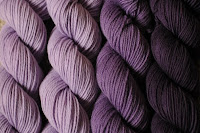Despite broken circs and several annoying knots in the yarn -- another of my pet peeves, that: yarn manufacturers sneakily knotting together their usually expensive yarn in mid-ball -- I finally managed to finish this sweater, and here it is:

I loosely followed Pamela Costello's
Incredible Custom-Fit Raglan, but I changed some of the calculations as I don't like the neck shape in the original pattern and I don't see the point of making the front wider than the back. Here are my changes:
Back stitches = total neck stitches x 0.39
Sleeve stitches = total neck stitches x 0.075
Yarn: 2/20NM soft spun cashmere, held double (works out slightly thinner than standard sockyarn)
Needles: 2.5mm circs
Gauge: 20sts/6cm = 3.33
I used only the four stitch markers at the raglans and didn't bother with the other ones. Began with a provisional cast-on over 64 back stitches and 17 stitches on each sleeve. Did the raglan increases in the regular way until the left and right front sections each had 17 sts, then increased as follows to create a rounded neck shape:
Row 1: incr 2 on either side (= 20 sts)
Row 3: incr 2 on either side (= 23 sts)
Row 5: incr 2 on either side (= 26 sts)
Row 7: incr 2 on either side (= 29 sts)
Row 9: incr 4 on either side (= 34 sts)
Row 11: incr 4 on either side (= 39 sts)
Row 13: incr 4 on either side (= 44 sts)
Row 15: incr 6 at start of row, work to end, join to round
Raglan increases then continued until the raglan measured 25cm, at which point there were 170 sts on the front and back and 122 on each sleeve.
Waist shaping: began in 3rd rd after dividing for sleeves. Kept one marker at each side and decreased 1 st on each side of marker every 3rd round for 33 rds. Worked straight until waist level, then increased again. (Did fewer hip increases and spaced them further apart, every 4 rds I think, but I see now that I wasn't taking notes as I went so I can't reconstruct this exactly. Oopsie.)
For the waistband I changed to 2mm needles, worked 10 rds ribbing, then kitchenered off.
Sleeves: Decreased every 10 rds, starting in rd 11, until 86 sts remained, then continued straight for 24 more rds. For cuffs: using 2mm needles, decreased by 1 st every 6sts (72 sts remaining), worked 10 rds ribbing, then kitchenered off.
Neckband: With 2mm needles, picked up 74 sts evenly from the front and the 98 held back and sleeve stitches from the provisional cast-on (= 172 sts). Decreased evenly to 146sts (1 for every 6 on back and sleeves, slightly less round the front), worked 10 rds ribbing, kitchenered off.
I'm very pleased with the result. But for my
next sweater, I think some heavier yarn and thicker needles would make a refreshing change!




































